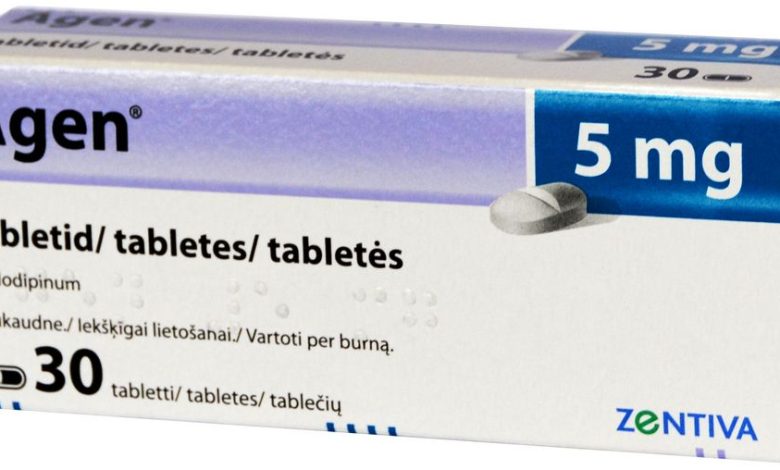Agent: instructions for using the medicine, structure, Contraindications

The mechanism of the antihypertensive effect of the drug Agen is due to a direct relaxing effect on vascular smooth muscles..
Agent: indications and dosage
- Arterial hypertension
- stable angina
- Vasospastic angina
Inside, regardless of the meal, drinking plenty of water.
With arterial hypertension and angina pectoris – 5 mg / day. If necessary, the daily dose may be increased to 10 mg / day. The maximum daily dose is 10 mg.
Any dose adjustment of Agen while using thiazide diuretics, beta-blockers or ACE inhibitors is not required.
Agent: overdose
Symptoms: severe peripheral vasodilation, marked reduction in blood pressure, tachycardia.
Treatment: therapy is carried out depending on the severity of the manifestation of intoxication. Gastric lavage, appointment of activated carbon, To maintain the function of the cardiovascular system, control performance of the heart and lungs, elevated position limbs, control of circulating blood volume and diuresis, symptomatic and supportive therapy. To restore vascular tone – use of vasopressors (in the absence of contraindications to their use); to deal with the consequences of the blockade calcium channels-in/with the introduction of Calcium Gluconate. Hemodialysis is not effective.
Agent: side effects
- Cardio-vascular system: heartbeat, breathlessness, marked reduction in blood pressure, fainting, vasculitis, swelling (swelling of the ankles and feet); rarely – heart rhythm disturbances (bradycardia, ventricular tachycardia, auricular flutter), chest pain, orthostatic hypotension.
- CNS: dizziness, headache, flushing, drowsiness, increased fatigue; rarely - mood changes, asthenia, muscle cramps, myalgia, blurred vision, paresthesia, tremor, insomnia.
- From the digestive system: dyspeptic disorders, nausea, hyperbilirubinemia, abdominal pain; rarely – increase in liver enzymes and jaundice (caused by cholestasis), pancreatitis, dysgeusia, dry mouth, change of bowel movements, giperplaziya right; rarely – gastritis .
- With the genitourinary system: rarely – thamuria, tenesmus, nocturia, reduced potency; rarely – dizurija, polyuria.
- From the musculoskeletal: arthralgia, myalgia.
- For the skin: rarely – dermatoxerasia, alopecia, dermatitis, purpura.
- Allergic reactions: itching, rash (incl. эritematoznaya, maculopapular rash, hives), angioedema.
- Other: increase / decrease in body weight, cough, rhinitis, gynecomastia, leukopenia, thrombocytopenia, giperglikemiâ.
Agent: Contraindications
- Severe arterial hypotension;
- Age to 18 years (efficacy and safety have not been established);
- Hypersensitivity to amlodipine and other derivatives of the dihydropyridine group.
The drug should be used with caution in patients with impaired liver and / or kidney function., chronic heart failure, sick sinus syndrome (vыrazhennaya bradycardia, tachycardia), aortic and mitral stenosis, hypertrophic obstructive cardiomyopathy, mild or moderate arterial hypotension, acute myocardial infarction (and for 1 Months after), diabetes, lipid profile disorder, elderly patients.
The safety of using Agen during pregnancy has not been established., Therefore, it is recommended to use only in those cases, when the risk, associated with the disease itself, exceeds the possible harm to the mother and fetus.
If necessary, the appointment during lactation should decide the issue of termination of breastfeeding.
Agent: interactions with other drugs and alcohol
Inhibitors of microsomal oxidation increase the concentration of amlodipine in plasma, increasing the risk of side effects, inducers of microsomal liver enzymes reduce the concentration of amlodipine.
Indomethacin and other NSAIDs (sodium retention and blockade of prostagland synthesis by the kidneys), alpha adrenostimulyatorov, sympathomimetics and estrogens (sodium retention) reduce the hypotensive effect of amlodipine.
Thiazide and ‘loop’’ Diuretic, beta-blockers, verapamil, ACE inhibitors and nitrates increase antianginal and hypotensive effects.
Amiodarone, quinidine, alpha1 blockers, antipsychotic drugs (neuroleptics) may enhance the hypotensive effect.
When amlodipine is taken simultaneously with lithium preparations, the manifestation of the neurotoxic effects of lithium may be enhanced. (nausea, vomiting, diarrhea, ataxia, noise in ears).
Does not affect the pharmacokinetic parameters of digoxin and warfarin.
Cimetidine have no influence on amlodipine farmakokinetiku.
Calcium can reduce the effect of calcium channel blockers slow.
Prokaynamyd, quinidine and other drugs, causing prolongation of the QT interval, reinforce the negative inotropic effect and may increase risk of significant lengthening of the QT interval.
Agent: composition and properties
White or almost white tablets, oblong, with a dividing line on one side and engraving ‘A’’ and '10'; of presentations – dense homogeneous mass of white or almost white color.
1 tab. amlodipine besylate 13.87 mg, which corresponds to the content of amlodipine 10 mg
White or almost white tablets, oblong, with a dividing line on one side and engraving ‘A’’ and '5'; of presentations – dense homogeneous mass of white or almost white color.
1 tab. amlodipine besylate 6.935 mg, which corresponds to the content of amlodipine 5 mg
Excipients: microcrystalline cellulose, calcium hydrogen phosphate dihydrate, sodium carboxymethyl starch type A, magnesium stearate.
Agent: release form
10 PC. – blisters (1) – packs cardboard.
10 PC. – blisters (3) – packs cardboard.
Agent: pharmachologic effect
Amlodipine – II generation slow calcium channel blocker from the group of dihydropyridine derivatives. Has antihypertensive, antianginal effect. Blocks the entry of calcium ions through cell membranes into smooth muscle cells of the myocardium and blood vessels.
The mechanism of hypotensive action is due to a direct relaxing effect on vascular smooth muscle.
The antianginal effect of the drug is due to the ability to expand peripheral arterioles, which leads to a decrease in total peripheral vascular resistance. Reducing the load on the heart leads to a decrease in myocardial oxygen demand. Under the influence of the drug, due to the expansion of the coronary arteries, the supply of oxygen to the myocardium increases (especially in vasospastic angina).
Does not adversely affect metabolism and plasma lipids, has anti-atherosclerotic, antithrombotic activity, increases glomerular filtration rate, It has a weak natriuretic effect. In diabetic nephropathy does not increase the severity of microalbuminuria.
The time of onset of effect – 2-4 no; duration – 24 no.
Agent: storage conditions
List B. Store in a dry, protected from light and out of reach of children, at temperatures up to 25°C. Shelf life – 3 year.
Agent: general information
Sales form: on prescription
